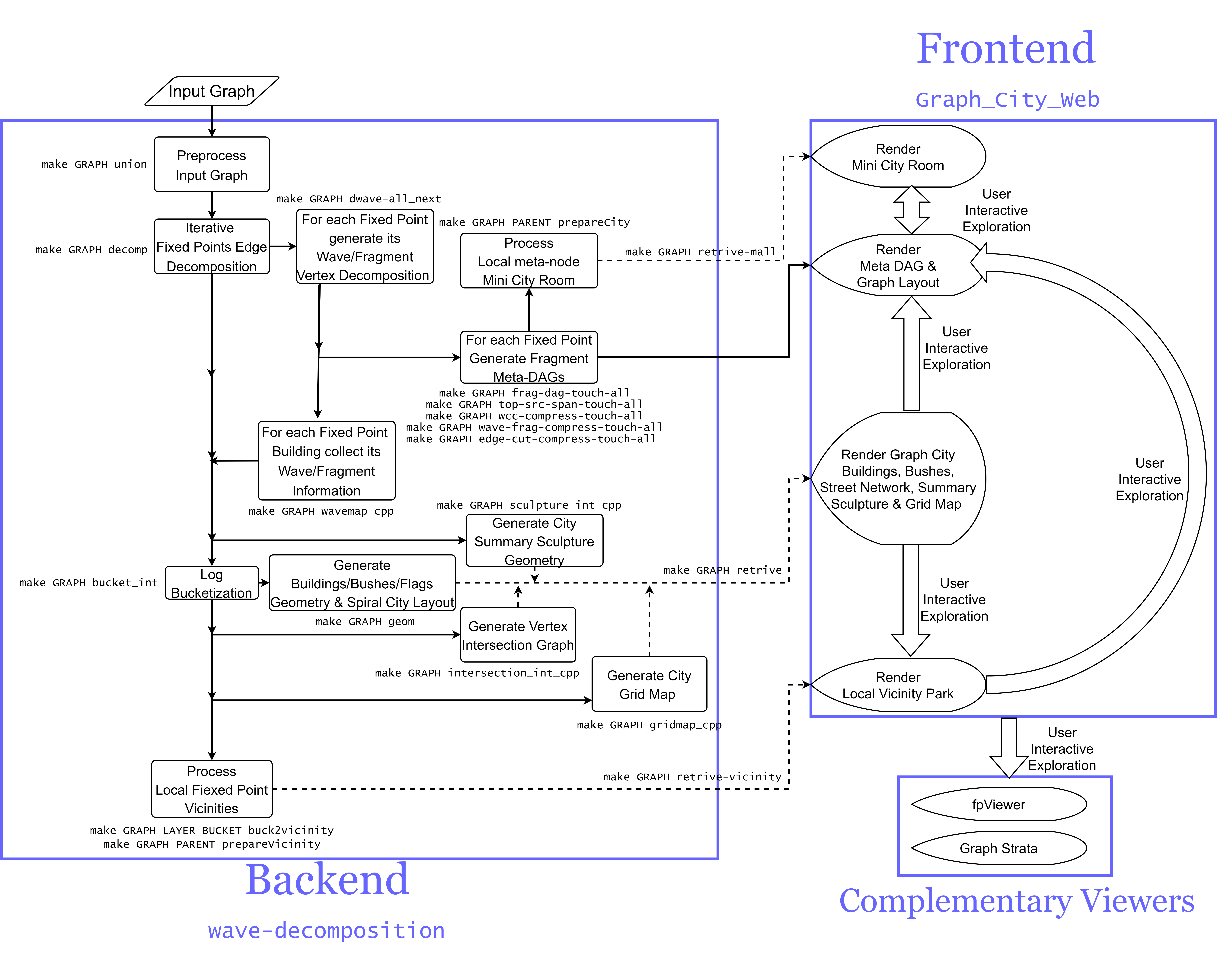Graph Cities are 3D visual representations of partitions of a graph edge set into maximal connected subgraphs each of which is called a fixed point of degree peeling. Each such connected subgraph is visually represented as a Building. A poly-log bucketization of the size distribution of the subgraphs represented by the buildings generates a 2D position for each bucket. The Delaunay triangulation of the bucket building locations determines the street network. We illustrate Graph Cities for the Friendster social network(1.8 billion edges), a co-occurrence keywords network derived from the Internet Movie Database (115 million edges), and a patent citation network(16.5 million edges). Up to 2 billion edges, all the elements of their corresponding Graph Cities are rendered in few minutes (excluding I/O time). The actual Graph Cities computation takes about 2 hours on a 64 GB RAM commodity computer. Our ultimate goal is to provide tools to build humanly interpretable descriptions of any graph, without being constrained by the graph size. It consists of four sub-modules: wave-decomposition, Graph_City_Web, fpViewer and graph-strata.
Web interactions are fully tested using Chrome. There are some issues with Safari. Therefore, we recommand for the current version to only use Chrome as a browser. A video illustrating our current interface can be accessed at here.
The main 2022 publication is:
@article{Abello2022GigaGC,
title={Giga Graph Cities: Their Buckets, Buildings, Waves, and Fragments},
author={James Abello and H. Zhang and Daniel Nakhimovich and Chengguizi Han and Mridul Aanjaneya},
journal={IEEE Computer Graphics and Applications},
year={2022},
volume={42},
pages={53-64}
}
Funding
This is an NSF-funded project (NSF IIS-1563816 and IIS-1563971), led by Prof. James Abello. It is partially funded by Nokia Bell Labs, Siemens Research, and mgvis.com. It constitutes a major part of the incoming Ph.D. thesis of Haoyang Zhang.
Credits
- Overall Project Design and Coordination: James Abello
- Algorithms: James Abello, Haoyang Zhang, and Daniel Nakhimovich
- Overall Integration and Platform Deployment: Haoyang Zhang
- Graph Cities Rendering: Chengguizi Han, Daniel Nakhimovich, and Mridul Aanjaneya
- Parallel computation for Meta-DAG: Ishaan Ivaturi
- Force Directed Layout Applications:
- fpViewer: James Abello and Haoyang Zhang
- Graph Strata base code: James Abello and Qi Dong
- Interaction Tools and Documentation: Haoyang Zhang, James Abello, and Shaad Quazi
- Data Sets Exploration: Fatima AlSaadeh, Tim Tangerlini, and Peter Broadwell
- Mini-Cloud Deployment: Haoyang Zhang, and Charles Hedrick
Preprocessed Data Sets
Large
| Name | Source | V | E | cc | FP |
|---|---|---|---|---|---|
| com-friendster | SNAP | 65608366 | 1806067135 | 1 | 72 |
| ogbn-papers100M | OGB | 111059956 | 1614062356 | 151 | 159 |
| movies-tag-cooccurence | IMDb | 218052 | 115050370 | 38 | 78 |
Medium
| name | Source | V | E | cc | FP |
|---|---|---|---|---|---|
| ogbn-products | OGB | 2400608 | 61859012 | 4237 | 102 |
| ogbn-proteins | OGB | 132534 | 39561252 | 1 | 157 |
| ogbn-mag | OGB | 1134649 | 21090258 | 1 | 64 |
| cit-Patents | SNAP | 3774768 | 16518947 | 3627 | 41 |
Small
| name | Source | V | E | cc | FP |
|---|---|---|---|---|---|
| Pandora papers | ICIJ Offshore Leaks Database | 1968951 | 2832596 | 31347 | 31 |
| ogbn-arxiv | OGB | 169343 | 1157799 | 1 | 22 |
Tiny
| name | V | E | cc | FP |
|---|---|---|---|---|
| Danish Fabula | 19738 | 28292 | 414 | 6 |
| Game of Thrones | 796 | 2823 | 1 | 9 |
| Starwars | 111 | 444 | 1 | 7 |
Sample Findings
A collection of “interesting” patterns can be accessed at Graph City Patten Gallery.
Papers
If you use our code, please consider citing our paper.
@article{Abello2022GigaGC,
title={Giga Graph Cities: Their Buckets, Buildings, Waves, and Fragments},
author={James Abello and H. Zhang and Daniel Nakhimovich and Chengguizi Han and Mridul Aanjaneya},
journal={IEEE Computer Graphics and Applications},
year={2022},
volume={42},
pages={53-64}
}
@inproceedings{Abello2021GraphCT,
title={Graph Cities: Their Buildings, Waves, and Fragments},
author={James Abello and Daniel Nakhimovich and Chengguizi Han and Mridul Aanjaneya},
booktitle={EDBT/ICDT Workshops},
year={2021}
}
@article{Abello2020GraphW,
title={Graph Waves},
author={James Abello and Daniel Nakhimovich},
journal={Big Data Res.},
year={2020},
volume={29},
pages={100327}
}
@article{Abello2013FixedPO,
title={Fixed points of graph peeling},
author={James Abello and François Queyroi},
journal={2013 IEEE/ACM International Conference on Advances in Social Networks Analysis and Mining (ASONAM 2013)},
year={2013},
pages={256-263}
}
Flowchart of Graph Cities Infrastructure
